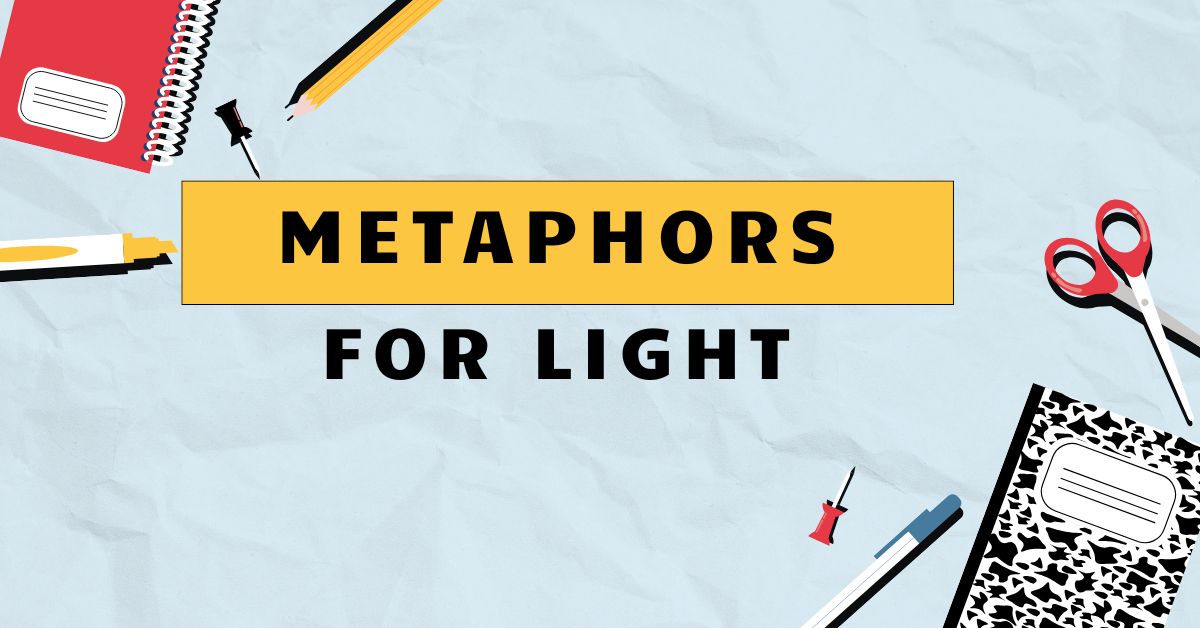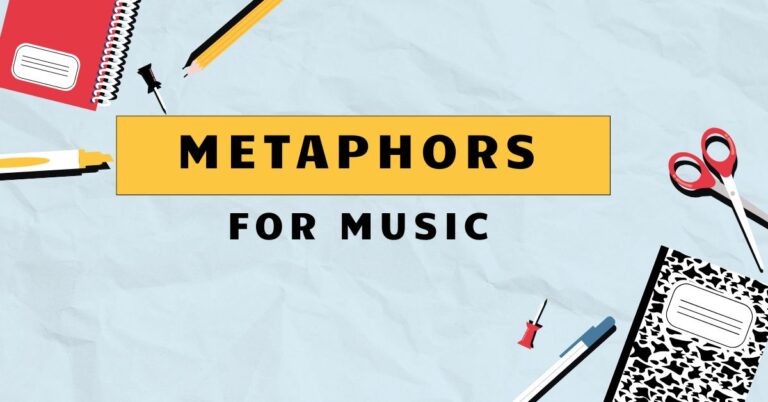40 Illuminating Language: Mastering Metaphors for Light
Understanding metaphors for light is crucial for comprehending nuanced and figurative language. Light, a fundamental aspect of our world, is frequently used metaphorically to represent abstract concepts such as knowledge, hope, truth, and understanding.
Mastering these metaphors enhances both reading comprehension and writing proficiency, allowing for more vivid and impactful communication. This article provides a comprehensive guide to identifying, interpreting, and using metaphors for light effectively.
This guide is perfect for ESL students, writers, and anyone keen to deepen their grasp of English language and literature. By exploring diverse examples and practical exercises, readers will gain a solid foundation in this essential area of figurative language.
Table of Contents
- Introduction
- Definition of Metaphors for Light
- Structural Breakdown
- Types and Categories
- Examples of Metaphors for Light
- Usage Rules
- Common Mistakes
- Practice Exercises
- Advanced Topics
- FAQ
- Conclusion
Definition of Metaphors for Light
A metaphor for light is a figure of speech that uses the concept of light to represent something else, typically an abstract idea or quality. Unlike similes, which make explicit comparisons using words like “like” or “as,” metaphors directly equate light with the concept being described.
The function of these metaphors is to create vivid imagery and deeper understanding by associating the tangible qualities of light—such as brightness, clarity, and warmth—with intangible concepts. Metaphors for light are commonly used in literature, poetry, and everyday language to convey complex ideas in a more accessible and evocative way.
The classification of metaphors for light falls under the broader category of conceptual metaphors, where one conceptual domain (light) is used to understand another (e.g., knowledge). These metaphors often rely on shared cultural understandings and experiences of light.
For instance, the association of light with knowledge is widespread across cultures, stemming from the idea that light illuminates what was previously hidden or unknown.
The contexts in which metaphors for light are used are incredibly varied. They appear in religious texts, philosophical treatises, scientific discourse (albeit often in a less figurative sense), and everyday conversations.
The specific meaning and impact of a metaphor for light depend heavily on the context in which it is used, as well as the intent of the speaker or writer.
Structural Breakdown
The structure of a metaphor for light typically involves two key elements: thetenorand thevehicle. The tenor is the abstract concept or idea being represented, while the vehicle is the concept of light itself, which is used to illuminate the tenor.
The relationship between the tenor and vehicle is not arbitrary; it is based on shared qualities or associations.
For example, in the metaphor “Her smile was a ray of sunshine,” the tenor is “her smile,” and the vehicle is “a ray of sunshine.” The shared quality is brightness and warmth, which are associated with both a smile and sunshine. The metaphor works because it evokes the feeling of warmth and happiness associated with sunshine, thus enhancing the description of the smile.
The effectiveness of a metaphor for light depends on the clarity and relevance of the connection between the tenor and the vehicle. A strong metaphor creates a vivid and insightful image, while a weak metaphor may be confusing or ineffective.
The cultural and contextual understanding of light also plays a crucial role in how the metaphor is interpreted.
Metaphors for light often involve related terms such as darkness, shadow, illumination, and radiance. These terms can further enrich the metaphor and add layers of meaning.
For instance, the contrast between light and darkness can be used to represent the contrast between knowledge and ignorance or good and evil.
Types and Categories
Light as Knowledge
This is perhaps the most common type of metaphor for light. Light represents understanding, insight, and the dispelling of ignorance.
Phrases like “shedding light on a problem” or “bringing something to light” exemplify this usage. The underlying idea is that knowledge illuminates what was previously obscure or hidden.
Light as Hope
Light can also symbolize hope, positivity, and optimism, especially in situations of despair or difficulty. A “beacon of light” or “a glimmer of hope” are examples of this.
The association stems from the idea that light provides guidance and reassurance in times of darkness.
Light as Truth
Light can represent truth, clarity, and honesty. The phrase “the light of truth” suggests that truth is clear, pure, and illuminating.
This metaphor is often used in contexts where deception or falsehood is present, with light representing the unveiling of what is real and genuine.
Light as Goodness or Purity
In many cultures, light is associated with goodness, purity, and virtue. This is evident in phrases like “an angel of light” or “a shining example.” The metaphor connects the inherent brightness and clarity of light with moral or ethical qualities.
Light as Inspiration
Light can also represent inspiration, creativity, and enlightenment. A “spark of inspiration” or “a flash of insight” are examples of this usage.
The metaphor suggests that inspiration is a sudden burst of clarity and understanding, similar to a flash of light.
Examples of Metaphors for Light
Below are examples of metaphors for light, organized by category, to illustrate the diverse ways in which light can be used figuratively.
Light as Knowledge Examples
The following table provides examples of metaphors where light represents knowledge. Each example is designed to illustrate how light is used to convey understanding and insight.
| Metaphor | Explanation |
|---|---|
| “His explanation shed light on the complex issue.” | The explanation clarified and made the issue understandable. |
| “The new discovery brought the truth to light.” | The discovery revealed the truth that was previously hidden. |
| “She illuminated the dark corners of the investigation.” | She clarified and revealed the hidden aspects of the investigation. |
| “The lecture was enlightening and shed light on many topics.” | The lecture provided knowledge and understanding of various topics. |
| “Research has thrown light on the causes of the disease.” | Research has provided insights into the causes of the disease. |
| “The teacher brought the subject to light for the students.” | The teacher made the subject understandable for the students. |
| “He sought to bring the truth to light, no matter the cost.” | He wanted to reveal the truth, regardless of the consequences. |
| “The evidence shed new light on the case.” | The evidence provided new insights into the case. |
| “Her insights illuminated the path forward.” | Her insights provided clarity and direction. |
| “The book shed light on the historical events.” | The book provided understanding and insight into the historical events. |
| “The documentary brought to light the plight of the refugees.” | The documentary revealed and made known the difficult situation of the refugees. |
| “The investigation aims to shed light on the corruption.” | The investigation seeks to uncover and clarify the corruption. |
| “His wisdom illuminated the room.” | His wisdom brought understanding and clarity to the situation. |
| “The data shone a light on the underlying trends.” | The data revealed and clarified the underlying trends. |
| “The seminar was designed to shed light on the latest research.” | The seminar aimed to provide insights into the latest research. |
| “Her presentation illuminated the key challenges.” | Her presentation clarified and highlighted the key challenges. |
| “The expert shed light on the intricacies of the market.” | The expert provided insights into the complex details of the market. |
| “The report brought to light the systemic issues.” | The report revealed and made known the systemic issues. |
| “The professor illuminated the complex theories.” | The professor clarified and explained the complex theories. |
| “The study shed light on the impact of social media.” | The study provided insights into the effects of social media. |
| “The article brought to light the hidden dangers.” | The article revealed and made known the hidden dangers. |
| “The analysis shone a light on the root causes.” | The analysis revealed and clarified the fundamental causes. |
| “The discussion shed light on the different perspectives.” | The discussion provided insights into the various viewpoints. |
| “The workshop illuminated the practical applications.” | The workshop clarified and demonstrated the practical uses. |
Light as Hope Examples
The following table provides examples of metaphors where light represents hope. Each example illustrates how light is used to convey optimism and positivity, especially in difficult circumstances.
| Metaphor | Explanation |
|---|---|
| “She was a beacon of light in his darkest hours.” | She provided hope and guidance during his most difficult times. |
| “Even in the deepest despair, there was a glimmer of light.” | Even in the worst situation, there was a small amount of hope. |
| “Her smile was a ray of sunshine after the storm.” | Her smile brought happiness and positivity after a difficult period. |
| “The new project was a light at the end of the tunnel.” | The new project offered hope for a positive outcome after a long struggle. |
| “His encouragement was a light in her life.” | His support brought hope and positivity to her. |
| “The community rallied, becoming a light in the darkness.” | The community provided hope and support during a difficult time. |
| “Her kindness was a beacon of light for the homeless.” | Her kindness provided hope and support for the homeless. |
| “The program offered a glimmer of hope to the struggling families.” | The program provided a small amount of hope to the families in need. |
| “His words were a ray of sunshine on a cloudy day.” | His words brought happiness and positivity to a gloomy situation. |
| “The victory was a light at the end of a long and arduous journey.” | The victory offered hope and a positive outcome after a long and difficult journey. |
| “She was the guiding light for her family during the crisis.” | She provided hope and direction for her family during the crisis. |
| “The charity became a beacon of light for the impoverished.” | The charity provided hope and support for the impoverished. |
| “Even in the darkest moments, faith was their glimmer of light.” | Even in the worst times, faith provided a small amount of hope. |
| “His optimism was a ray of sunshine in the depressing office.” | His optimism brought happiness and positivity to the gloomy office. |
| “The scholarship was a light at the end of her financial struggles.” | The scholarship offered hope for a positive outcome after a long period of financial difficulty. |
| “Her positive attitude was a light in the hospital ward.” | Her positive attitude brought hope and positivity to the patients in the hospital. |
| “The support group became a beacon of light for the grieving.” | The support group provided hope and support for those who were grieving. |
| “The small act of kindness was a glimmer of hope in the chaos.” | The small act of kindness offered a small amount of hope in the midst of a chaotic situation. |
| “His encouragement was a ray of sunshine after the bad news.” | His support brought happiness and positivity after receiving bad news. |
| “The new law was a light at the end of the corrupt system.” | The new law offered hope for a positive outcome after a long period of corruption. |
| “She was a guiding light for her students, always encouraging them to persevere.” | She provided hope and direction for her students, always motivating them to continue. |
| “The volunteer work became a beacon of light for the community.” | The volunteer work provided hope and support for the community. |
| “Even in the face of adversity, their resilience was a glimmer of light.” | Even when facing difficulties, their strength provided a small amount of hope. |
| “His positive outlook was a ray of sunshine during the challenging project.” | His optimistic perspective brought happiness and positivity to the difficult project. |
Light as Truth Examples
The following table provides examples of metaphors where light represents truth. Each example demonstrates how light is used to convey clarity, honesty, and the unveiling of what is real and genuine.
| Metaphor | Explanation |
|---|---|
| “The investigation brought the truth to light.” | The investigation revealed the actual facts and circumstances. |
| “She sought the light of truth in her research.” | She aimed to find and reveal the genuine facts in her research. |
| “The evidence shone a light on the real culprit.” | The evidence revealed and clarified the identity of the actual perpetrator. |
| “He always strove to live in the light of truth.” | He always tried to live honestly and genuinely. |
| “The journalist exposed the scandal, bringing the truth to light.” | The journalist revealed the scandalous events and made them known. |
| “Her honesty was like a bright light in a dark room.” | Her honesty was clear and revealing in a deceptive environment. |
| “The document illuminated the hidden facts.” | The document clarified and revealed the facts that were previously concealed. |
| “They sought to uncover the truth and bring it into the light.” | They aimed to reveal the truth and make it known. |
| “His words were a beacon of truth in a sea of lies.” | His statements were honest and revealing in a context filled with deception. |
| “The trial shed light on the actual events.” | The trial revealed and clarified the real occurrences. |
| “She dedicated her life to seeking the light of truth and justice.” | She committed herself to finding and revealing the genuine facts and fairness. |
| “The investigation aimed to bring the hidden facts into the light.” | The investigation sought to reveal and clarify the concealed information. |
| “His integrity shone like a light in the corrupt organization.” | His honesty and moral principles were evident in the dishonest environment. |
| “The report illuminated the systemic issues within the institution.” | The report clarified and revealed the problems present in the institution. |
| “They worked tirelessly to bring the truth to light, regardless of the consequences.” | They endeavored to reveal the genuine facts, irrespective of the repercussions. |
| “Her testimony was a beacon of truth in the courtroom.” | Her statement was honest and revealing in the legal setting. |
| “The research shone a light on the underlying causes of the problem.” | The research clarified and revealed the fundamental reasons for the issue. |
| “He vowed to uncover the truth and bring it into the light for everyone to see.” | He promised to reveal the genuine facts and make them known to all. |
| “Her commitment to honesty was like a bright light in a world of deceit.” | Her dedication to truthfulness was clear and revealing in a deceptive world. |
| “The evidence illuminated the actual sequence of events.” | The evidence clarified and revealed the real order of occurrences. |
| “She dedicated her career to bringing the light of truth to the public.” | She committed her professional life to revealing the genuine facts to the people. |
| “The investigation aimed to uncover the hidden truths and bring them into the light.” | The investigation sought to reveal the concealed facts and make them known. |
| “His unwavering honesty was a beacon of truth in the political arena.” | His steadfast integrity was clear and revealing in the political environment. |
| “The data illuminated the disparities in the healthcare system.” | The data clarified and revealed the inequalities in the healthcare system. |
Light as Goodness Examples
The following table provides examples of metaphors where light represents goodness or purity. Each example illustrates how light is used to convey moral or ethical qualities, often associated with virtue and integrity.
| Metaphor | Explanation |
|---|---|
| “She was an angel of light, always helping those in need.” | She was a kind and virtuous person, consistently assisting others. |
| “His actions were a shining example of integrity.” | His behavior was a clear demonstration of honesty and moral principles. |
| “Her purity shone like a bright light.” | Her innocence and virtue were evident and radiant. |
| “He was a beacon of goodness in a corrupt world.” | He was a source of moral guidance and virtue in a dishonest environment. |
| “Her kindness illuminated the lives of everyone she met.” | Her compassion and generosity positively influenced the lives of those she encountered. |
| “His virtue was like a light that guided others.” | His moral excellence served as a guide for others. |
| “She embodied the light of goodness and compassion.” | She represented and demonstrated kindness and empathy. |
| “His integrity shone brightly, illuminating the path for others.” | His honesty and moral principles served as a clear example for others to follow. |
| “Her actions were a testament to the light of human kindness.” | Her behavior demonstrated the positive qualities of human compassion. |
| “He was a shining example of moral rectitude.” | He was a clear demonstration of moral correctness and integrity. |
| “Her goodness was a light that dispelled the darkness around her.” | Her kindness and virtue overcame the negativity and corruption. |
| “His actions reflected the light of compassion and empathy.” | His behavior demonstrated kindness and understanding towards others. |
| “She was a beacon of light, guiding others with her moral compass.” | She was a source of moral guidance, leading others with her strong sense of right and wrong. |
| “His virtue shone through, illuminating the hearts of those he touched.” | His moral excellence influenced and inspired those he came into contact with. |
| “Her actions were a manifestation of the light of human goodness.” | Her behavior demonstrated the positive qualities of human kindness and virtue. |
| “He was a shining example of ethical conduct.” | He was a clear demonstration of ethical and moral behavior. |
| “Her compassion illuminated the suffering of others.” | Her empathy and kindness brought attention to and alleviated the suffering of others. |
| “His integrity was a light that guided him through difficult decisions.” | His honesty and moral principles helped him make ethical choices in challenging situations. |
| “She embodied the light of moral purity and integrity.” | She represented and demonstrated moral innocence and honesty. |
| “His actions reflected the light of unwavering goodness.” | His behavior demonstrated consistent and steadfast kindness and virtue. |
| “She was a beacon of light, inspiring others with her virtuous deeds.” | She was a source of moral guidance, motivating others with her kind and ethical actions. |
| “His virtue shone brightly, illuminating the lives of those he served.” | His moral excellence positively influenced the lives of those he helped. |
| “Her actions were a testament to the light of selfless service.” | Her behavior demonstrated the positive qualities of serving others without personal gain. |
| “He was a shining example of ethical leadership.” | He was a clear demonstration of ethical and moral leadership qualities. |
Light as Inspiration Examples
The following table provides examples of metaphors where light represents inspiration. Each example illustrates how light is used to convey creativity, enlightenment, and sudden bursts of understanding.
| Metaphor | Explanation |
|---|---|
| “She had a spark of inspiration that led to her groundbreaking invention.” | She experienced a sudden burst of creativity that resulted in her innovative creation. |
| “His words ignited a flame of inspiration in the students.” | His speech stimulated creativity and motivation in the students. |
| “The idea was a flash of insight that changed his perspective.” | The concept was a sudden and clear understanding that altered his viewpoint. |
| “Her creativity shone like a bright light, illuminating new possibilities.” | Her innovative thinking revealed and clarified new opportunities. |
| “He found inspiration in the beauty of nature, which sparked his artistic vision.” | He was motivated by the natural world, which stimulated his creative ideas. |
| “The conference was a beacon of inspiration for entrepreneurs.” | The event was a source of motivation and creative ideas for business owners. |
| “Her passion ignited a flame of inspiration in her colleagues.” | Her enthusiasm stimulated creativity and motivation in her coworkers. |
| “The museum was a light of inspiration for the young artists.” | The museum served as a source of creative ideas and motivation for the young artists. |
| “His lecture was a spark of inspiration that led to innovative projects.” | His speech stimulated creativity and resulted in new and inventive projects. |
| “She was a guiding light for aspiring writers, inspiring them to pursue their dreams.” | She served as a source of motivation and direction for writers, encouraging them to follow their ambitions. |
| “The workshop was a beacon of inspiration for educators.” | The workshop was a source of motivation and creative ideas for teachers. |
| “His vision ignited a flame of inspiration in the community.” | His ideas stimulated creativity and motivation in the local area. |
| “The art exhibit was a light of inspiration for the visitors.” | The art show served as a source of creative ideas and motivation for the attendees. |
| “Her mentorship was a spark of inspiration that helped him achieve his goals.” | Her guidance stimulated creativity and helped him accomplish his objectives. |
| “The retreat was a beacon of inspiration for spiritual seekers.” | The retreat was a source of motivation and creative ideas for those seeking spiritual enlightenment. |
| “His music ignited a flame of inspiration in the audience.” | His musical performance stimulated creativity and motivation in the listeners. |
| “The novel was a light of inspiration for many readers.” | The book served as a source of creative ideas and motivation for many people. |
| “Her guidance was a spark of inspiration that led to innovative solutions.” | Her direction stimulated creativity and resulted in new and inventive answers. |
| “The seminar was a beacon of inspiration for business leaders.” | The seminar was a source of motivation and creative ideas for executives. |
| “His speech ignited a flame of inspiration in the volunteers.” | His address stimulated creativity and motivation in the volunteers. |
| “The film was a light of inspiration for aspiring filmmakers.” | The movie served as a source of creative ideas and motivation for those pursuing filmmaking. |
| “Her encouragement was a spark of inspiration that helped her team succeed.” | Her support stimulated creativity and helped her team achieve their goals. |
| “The conference was a beacon of inspiration for researchers.” | The conference was a source of motivation and creative ideas for scientists. |
| “His leadership ignited a flame of inspiration in the employees.” | His management stimulated creativity and motivation in the workers. |
Usage Rules
When using metaphors for light, it’s important to ensure that the comparison between light and the concept being represented is clear and relevant. Avoid mixing metaphors, which can create confusion and weaken the impact of your writing.
For instance, avoid phrases like “a ray of hope that rained down on the situation,” as the imagery of rain clashes with the metaphor of light.
Consider the context in which you are using the metaphor. The meaning and impact of a metaphor for light can vary depending on the audience and the overall tone of your writing.
Be mindful of cultural associations with light, as these can also influence how the metaphor is interpreted.
Use metaphors for light sparingly and strategically. Overusing metaphors can make your writing seem cliché or contrived.
Choose metaphors that are fresh and original, and use them to enhance your writing rather than distract from it.
Common Mistakes
One common mistake is using clichés. Phrases like “a light at the end of the tunnel” are overused and can lack impact.
Strive for originality in your metaphors.
Another common mistake is creating mixed metaphors, where the imagery clashes. For example:
- Incorrect: “The idea was a spark that drowned in a sea of doubt.” (Sparks don’t drown.)
- Correct: “The idea was a spark that ignited a flame of hope.”
Misunderstanding the cultural context can also lead to errors. Ensure that your metaphor resonates with your intended audience and does not inadvertently offend or confuse.
Here are some more examples of common mistakes along with their corrections:
| Incorrect | Correct | Explanation |
|---|---|---|
| “His anger shone brightly.” | “His anger burned fiercely.” | Anger is typically associated with heat and fire, not light. |
| “The problem was as bright as a dark night.” | “The problem was as clear as day.” | “Bright” and “dark night” are contradictory. “Clear as day” is a common idiom for clarity. |
| “She was a light in the shadow of success.” | “She was a light in the shadow of adversity.” | Success does not typically cast a shadow. Adversity or hardship does. |
| “The news cast a bright shadow on their hopes.” | “The news cast a dark shadow on their hopes.” | Shadows are generally dark, not bright, especially when affecting hopes negatively. |
| “He illuminated the darkness with his loud voice.” | “He pierced the darkness with his sharp wit.” | Illumination is usually associated with light or understanding, not sound. |
Practice Exercises
Exercise 1: Identifying Metaphors
Identify the metaphor for light in each sentence and explain what it represents.
| Question | Answer |
|---|---|
| 1. Her wisdom was a beacon of light in the confusing debate. | Beacon of light represents guidance and clarity. |
| 2. The truth shone like a bright star, revealing the lies. | Bright star represents truth and clarity. |
| 3. His encouragement was a ray of sunshine on a cloudy day. | Ray of sunshine represents hope and positivity. |
| 4. The new evidence shed light on the mystery. | Shed light represents clarification and understanding. |
| 5. She was a guiding light for her students. | Guiding light represents direction and inspiration. |
| 6. The solution was a spark of inspiration. | Spark of inspiration represents creativity and insight. |
| 7. The charity was a beacon of hope for the refugees. | Beacon of hope represents support and optimism. |
| 8. His honesty illuminated the room. | Illuminated represents truth and clarity. |
| 9. The discovery brought the truth to light. | Brought to light represents revelation and understanding. |
| 10. She was an angel of light, helping everyone she met. | Angel of light represents goodness and purity. |
Exercise 2: Interpreting Metaphors
Explain the meaning of each metaphor in your own words.
| Question | Answer |
|---|---|
| 1. “The teacher’s explanation shed light on the complex topic.” | The teacher made the complex topic easier to understand. |
| 2. “Even in the darkest times, her smile was a glimmer of light.” | Even in the worst situations, her smile offered a small amount of hope. |
| 3. “The investigation brought to light the corruption within the company.” | The investigation revealed the corrupt activities that were happening within the company. |
| 4. “He sought the light of truth in his research.” | He aimed to find and reveal the genuine facts in his research. |
| 5. “Her kindness was a beacon of light for the homeless.” | Her kindness provided hope and support for the homeless. |
| 6. “The new idea was a spark of inspiration that could change the world.” | The new idea was a burst of creativity that had the potential to make a significant impact. |
| 7. “The program offered a glimmer of hope to the struggling families.” | The program provided a small amount of optimism to the families facing difficulties. |
| 8. “His words were a ray of sunshine on a cloudy day.” | His words brought happiness and positivity to a gloomy situation. |
| 9. “The victory was a light at the end of a long and arduous journey.” | The victory offered hope and a positive outcome after a long and difficult period. |
| 10. “She was the guiding light for her family during the crisis.” | She provided hope and direction for her family during the difficult time. |
Exercise 3: Using Metaphors
Complete each sentence using a metaphor for light.
| Question | Answer |
|---|---|
| 1. After years of searching, the answer was finally ____. | After years of searching, the answer was finally brought to light. |
| 2. In his darkest hour, her friendship was ____. | In his darkest hour, her friendship was a beacon of light. |
| 3. The new discovery ____ on the origins of the universe. | The new discovery shed light on the origins of the universe. |
| 4. His honesty ____ in a world of deceit. | His honesty shone brightly in a world of deceit. |
| 5. The teacher’s passion for the subject ____ in her students. | The teacher’s passion for the subject ignited a spark of inspiration in her students. |
| 6. Even when facing challenges, her optimism remained ____. | Even when facing challenges, her optimism remained a guiding light. |
| 7. The charity’s work ____ for those in need. | The charity’s work was a beacon of hope for those in need. |
| 8. Her innovative ideas ____ new possibilities. | Her innovative ideas illuminated new possibilities. |
| 9. The evidence ____ on the truth of the matter. | The evidence shone a light on the truth of the matter. |
| 10. She was ____ for all who knew her. | She was an angel of light for all who knew her. |
Advanced Topics
For advanced learners, exploring the cultural and historical contexts of metaphors for light can provide deeper insights. Consider how different cultures associate light with various concepts and how these associations have evolved over time.
Analyzing the use of metaphors for light in literature, poetry, and philosophical texts can also enhance understanding and appreciation of figurative language.
Furthermore, exploring the interplay between light and darkness in metaphorical language can reveal complex themes and ideas. The contrast between light and darkness is often used to represent opposing forces, such as good and evil, knowledge and ignorance, or hope and despair.
Analyzing how these contrasts are used in different contexts can provide a richer understanding of the metaphorical landscape.
Another advanced topic is the study of synesthesia, where different senses are combined to create vivid imagery. For example, describing a sound as “bright” or a color as “loud” involves synesthetic metaphors that can enhance the sensory experience of language.
Exploring the use of synesthesia in conjunction with
metaphors for light can lead to more creative and impactful writing.
FAQ
Q: What is the difference between a simile and a metaphor for light?
A: A simile uses “like” or “as” to make a comparison (e.g., “Her smile was like a ray of sunshine”), while a metaphor directly equates light with something else (e.g., “Her smile was a ray of sunshine”).
Q: Why is light so often used as a metaphor?
A: Light is a fundamental and universally understood concept associated with clarity, knowledge, hope, and goodness, making it a powerful and versatile metaphor.
Q: How can I avoid using clichés when writing metaphors for light?
A: Strive for originality by focusing on specific qualities of light and finding unique ways to connect them to the concept you are describing. Read widely and pay attention to how other writers use metaphors effectively.
Q: Can metaphors for light be used in scientific writing?
A: While scientific writing generally avoids figurative language, metaphors for light can be used sparingly to explain complex concepts or create a more engaging tone, provided they do not compromise clarity and accuracy.
Q: How do cultural differences affect the interpretation of metaphors for light?
A: Different cultures may have varying associations with light, so it’s important to be mindful of your audience and choose metaphors that resonate with their cultural background. For example, some cultures associate certain colors of light with specific emotions or ideas.
Conclusion
Metaphors for light are powerful tools for enhancing communication and creating vivid imagery. By understanding the different types and categories of these metaphors, following usage rules, and avoiding common mistakes, you can effectively incorporate them into your writing and speaking.
Practice the exercises provided to sharpen your skills and deepen your appreciation for the illuminating language of metaphors for light. With continued learning and application, you can master the art of using metaphors for light to convey complex ideas with clarity, creativity, and impact.







